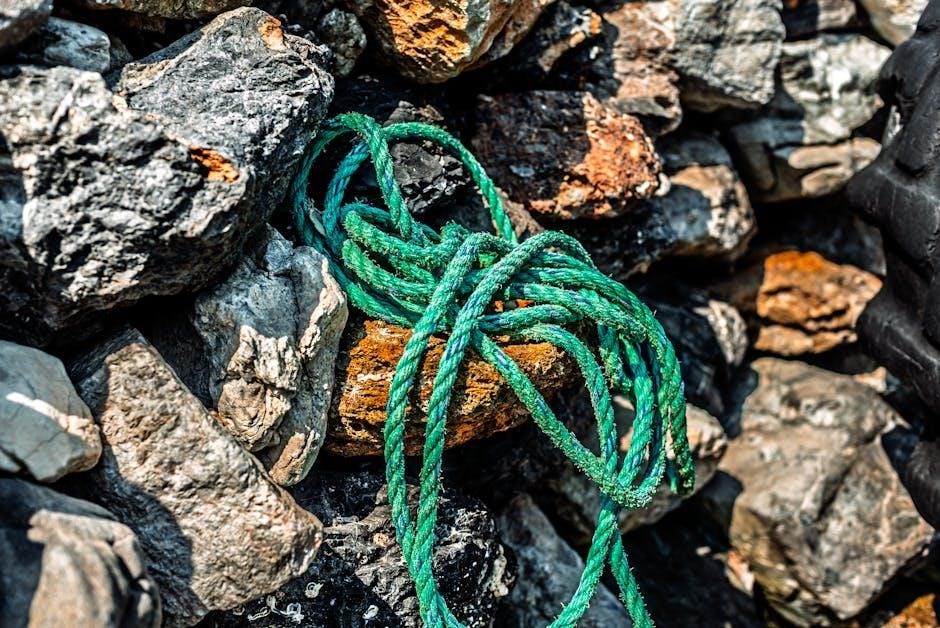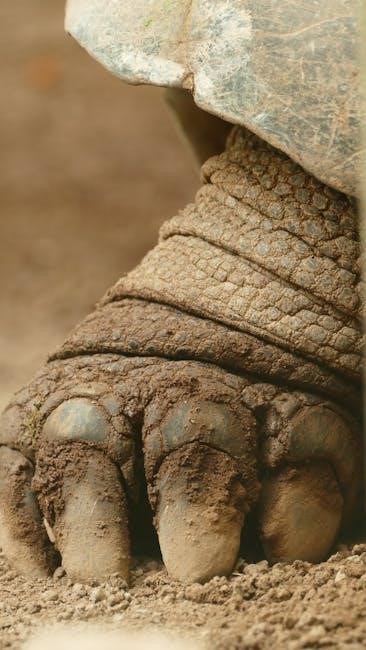The Mohs Hardness Scale is a quick‚ convenient tool for identifying minerals by their scratch resistance. It defines hardness as a mineral’s resistance to scratching‚ using ten reference minerals. Widely used in geology and gemology.
1.1 Definition and Overview
The Mohs Hardness Scale is a relative measure of a mineral’s resistance to scratching‚ defined by its ability to withstand abrasion from harder substances. It ranks minerals on a scale of 1 to 10‚ with talc being the softest (1) and diamond the hardest (10). This scale is based on ten reference minerals‚ providing a practical framework for identifying and comparing mineral hardness. It is widely used in geology‚ gemology‚ and industrial applications to assess surface durability and scratch resistance of materials.
1.2 Importance in Mineral Identification
The Mohs Hardness Scale is a foundational tool in mineral identification‚ offering a straightforward method to determine a mineral’s resistance to scratching. By comparing an unknown mineral to the ten reference minerals‚ geologists and gemologists can quickly identify species. This scale is particularly valuable because hardness is a consistent property for most minerals‚ making it a reliable identifier. Its simplicity and non-destructive nature make it an essential technique in fieldwork and laboratory settings‚ aiding in the classification and study of mineral samples effectively.

History and Development of the Mohs Hardness Scale
The Mohs Hardness Scale was developed in 1812 by Friedrich Mohs‚ a German mineralogist; It introduced a method to rank minerals based on scratch resistance‚ using ten reference minerals.
2.1 Friedrich Mohs and His Contributions
Friedrich Mohs‚ a German mineralogist‚ developed the Mohs Hardness Scale in 1812. He selected ten common minerals‚ ranking them from softest to hardest‚ to create a practical tool for mineral identification. Mohs’ work laid the foundation for understanding mineral properties‚ particularly scratch resistance‚ which remains vital in geology and gemology. His contributions revolutionized how minerals are classified and identified‚ making the scale an enduring and essential tool in Earth sciences.
2.2 The Selection of Reference Minerals
Friedrich Mohs chose ten minerals for his scale based on their availability and distinct hardness levels. The selected minerals—talc (1)‚ gypsum (2)‚ calcite (3)‚ fluorite (4)‚ apatite (5)‚ orthoclase (6)‚ quartz (7)‚ topaz (8)‚ corundum (9)‚ and diamond (10)—represent a gradual increase in scratch resistance. This selection ensured the scale’s practicality and applicability for mineral identification. The reference minerals were readily accessible‚ making the scale widely usable in geological studies and fieldwork‚ and their hardness levels provided clear differentiation for classification purposes.

The 10 Reference Minerals on the Mohs Scale
The Mohs Scale includes ten minerals: talc‚ gypsum‚ calcite‚ fluorite‚ apatite‚ orthoclase‚ quartz‚ topaz‚ corundum‚ and diamond‚ ranging from softest (1) to hardest (10) for mineral identification.
3.1 List of Minerals and Their Hardness Ratings
The Mohs Scale ranks minerals from 1 (softest) to 10 (hardest). The reference minerals are: talc (1)‚ gypsum (2)‚ calcite (3)‚ fluorite (4)‚ apatite (5)‚ orthoclase (6)‚ quartz (7)‚ topaz (8)‚ corundum (9)‚ and diamond (10). These minerals serve as standard reference points for determining the hardness of other minerals. Their hardness ratings are widely accepted and used in geology and gemology for identification and classification purposes.
3.2 Key Characteristics of Each Mineral
Each mineral on the Mohs Scale has distinct physical properties. Talc is soft and powdery‚ while gypsum is hydrated calcium sulfate. Calcite is common in limestone and exhibits cleavage. Fluorite often has vibrant colors and a glassy luster. Apatite is found in pegmatites and has a hexagonal crystal structure. Orthoclase is a pink feldspar with a Mohs hardness of 6. Quartz is one of the most common minerals‚ known for its hexagonal crystals. Topaz is prized for its gemstone quality‚ while corundum‚ including ruby and sapphire‚ is highly durable. Diamond‚ the hardest‚ has exceptional brilliance and conductivity.

How the Mohs Hardness Scale Works
The Mohs Hardness Scale determines a mineral’s hardness by its resistance to scratching. A reference mineral scratches the test mineral; if it leaves a mark‚ it is softer. This simple yet effective method helps classify minerals based on their scratch resistance‚ providing a practical tool for geologists and gemologists.
4.1 The Scratch Test Methodology
The scratch test involves using a reference mineral from the Mohs scale to determine the hardness of a test mineral. A mineral is scratched against another‚ and the result is observed. If the reference mineral leaves a scratch‚ the test mineral is softer. This method is simple and effective‚ providing a clear hardness ranking. It relies on the principle that harder minerals can scratch softer ones. The test is widely used in geology and gemology for quick and accurate mineral identification‚ helping to classify specimens based on their scratch resistance.
4.2 Interpreting Scratch Test Results
Interpreting scratch test results involves determining the relative hardness of a mineral based on whether it is scratched by a reference mineral. If the reference mineral leaves a visible mark‚ the test mineral is softer. If no scratch occurs‚ the test mineral is harder. The hardness rating is assigned based on these observations. This method is reliable for comparing minerals‚ though variations in crystal direction and mineral impurities can affect results. Accurate interpretation ensures proper classification and identification of minerals using the Mohs scale.

Applications of the Mohs Hardness Scale
The Mohs Hardness Scale is widely used in geology‚ mineralogy‚ and gemology for identifying minerals and assessing their scratch resistance. It aids in gemstone cutting and industrial material selection for durability‚ making it a practical tool across various fields.
5.1 Use in Geology and Mineralogy
The Mohs Hardness Scale is a fundamental tool in geology and mineralogy for identifying minerals based on their scratch resistance. Geologists use it to determine a mineral’s hardness‚ which helps in classification and distinguishing similar species. The scale’s simplicity allows fieldwork without advanced equipment‚ making it invaluable for rapid assessments. By comparing samples to the ten reference minerals‚ professionals can accurately determine a mineral’s hardness‚ aiding in understanding its composition and properties. This method is essential for field studies‚ mineral exploration‚ and educational purposes‚ providing a practical framework for mineral identification and analysis.
5.2 Practical Applications in Gemology
The Mohs Hardness Scale is crucial in gemology for assessing gemstone durability and suitability for jewelry. By determining a gemstone’s resistance to scratching‚ gemologists can evaluate its wearability and longevity. This scale helps differentiate between similar-looking gemstones‚ such as distinguishing diamonds (hardness 10) from quartz (hardness 7). It also guides jewelers in setting and cutting gemstones‚ ensuring they withstand daily wear. Additionally‚ the scale aids in identifying treatments or enhancements that might affect a gemstone’s hardness‚ ensuring authenticity and quality in the gem trade.

5.3 Industrial and Engineering Uses
The Mohs Hardness Scale is valuable in industrial and engineering contexts for material selection and machinery protection. It helps determine the durability of materials against abrasion‚ crucial for construction and manufacturing. For instance‚ understanding a material’s hardness aids in choosing appropriate cutting tools and preventing wear. In mining‚ it helps optimize extraction processes by identifying ore hardness. Additionally‚ the scale is used in materials science to assess surface durability for applications like bearings and mechanical components‚ ensuring longevity and performance in industrial settings.

Limitations of the Mohs Hardness Scale
The scale is relative‚ not absolute‚ and hardness can vary on different crystal faces. It doesn’t measure absolute hardness and is less precise for directional hardness differences.
6.1 Variability in Mineral Hardness
The Mohs Hardness Scale is a relative measure‚ meaning it compares minerals to each other rather than providing an absolute hardness value. This relativity can lead to variability‚ as the hardness of a mineral can differ slightly depending on the crystal face being tested. For example‚ the same mineral may exhibit different hardness levels when scratched in different directions due to its crystal structure. This variability highlights the importance of testing multiple faces for accurate results. Additionally‚ some minerals may have slight hardness variations due to impurities or structural differences‚ further complicating precise measurements.
6.2 Comparison with Absolute Hardness Scales
The Mohs Hardness Scale is a relative measure‚ whereas absolute hardness scales‚ like the Knoop or Vickers scales‚ provide precise‚ quantitative measurements. Unlike Mohs‚ which ranks minerals from 1 to 10 based on scratch resistance‚ absolute scales measure hardness using indentations under controlled forces. This makes absolute scales more precise for scientific and engineering applications. However‚ the Mohs scale remains practical for fieldwork and general identification due to its simplicity and reliance on readily available reference minerals. Despite its limitations‚ it complements absolute hardness measurements effectively in many contexts.

Comparing the Mohs Scale to Other Hardness Tests
The Mohs scale offers a simplistic method for comparing mineral hardness through relative scratch resistance‚ differing from absolute hardness scales that provide precise‚ quantitative measurements.
7.1 Mohs vs. Absolute Hardness Scales
The Mohs hardness scale is a relative measure‚ ranking minerals from 1 to 10 based on scratch resistance. In contrast‚ absolute hardness scales‚ like the Knoop or Vickers scales‚ provide precise‚ quantitative measurements of a material’s hardness. While Mohs is simple and practical for field use‚ absolute scales are more accurate and scientifically rigorous. Mohs is ideal for quick mineral identification‚ whereas absolute scales are used in engineering and materials science for detailed hardness analysis. This comparison highlights the trade-off between simplicity and precision in hardness testing methods.
7.2 Advantages of the Mohs Scale
The Mohs hardness scale offers several advantages‚ particularly its simplicity and accessibility. It provides a straightforward‚ relative hardness ranking‚ making it easy to understand and apply in fieldwork. Unlike absolute hardness scales‚ Mohs does not require specialized equipment‚ allowing geologists and gemologists to test minerals quickly and cost-effectively. Its practicality makes it an essential tool for mineral identification and educational purposes. Additionally‚ the scale’s intuitive nature ensures that even those without advanced training can use it effectively‚ fostering wider adoption in various fields.

Tips for Using the Mohs Hardness Scale
Use reference minerals to test hardness accurately. Ensure surfaces are clean and flat for reliable results. Scratch gently to avoid damaging the sample or reference minerals.
8.1 Conducting Accurate Scratch Tests
To ensure accurate results when using the Mohs Hardness Scale‚ start by selecting a clean‚ flat surface on both the test mineral and the reference mineral. Gently scratch the test mineral with the reference mineral‚ applying consistent pressure. Avoid using damaged or uneven surfaces‚ as this can lead to unreliable results. Test multiple faces if possible‚ as hardness may vary depending on the crystal structure. Document your observations carefully to determine the relative hardness effectively. This method ensures precise identification and minimizes errors in mineral classification.
8.2 Identifying Minerals Effectively
Effective mineral identification using the Mohs Hardness Scale involves combining scratch test results with other physical properties. Start by performing the scratch test accurately to determine hardness. Observe the mineral’s crystal structure‚ cleavage‚ and color to supplement hardness data. Testing multiple faces can reveal variability in hardness. Cross-referencing with additional properties‚ such as luster and streak‚ enhances accuracy. Using a reference chart or guide alongside the scale ensures reliable identification. This comprehensive approach helps distinguish minerals with similar hardness values‚ making the process efficient and precise for geologists and hobbyists alike.
The Mohs Hardness Scale is a fundamental tool for identifying minerals‚ providing a simple yet effective method to determine scratch resistance. Its applications span geology‚ gemology‚ and industry‚ offering a practical framework for understanding mineral durability. While it has limitations‚ the scale remains indispensable for fieldwork and laboratory use‚ continuing to aid mineralogists and enthusiasts alike in their studies and discoveries.
9.1 Summary of Key Points
The Mohs Hardness Scale is a widely used method for determining mineral hardness through scratch resistance. Developed by Friedrich Mohs in 1822‚ it ranks minerals from 1 (softest) to 10 (hardest). The scale relies on ten reference minerals‚ including talc‚ quartz‚ and diamond. It is a practical tool in geology and gemology for identifying minerals and assessing their durability. While it has limitations‚ such as variability in mineral hardness‚ the scale remains essential for fieldwork and laboratory use due to its simplicity and effectiveness in mineral identification and characterization.
9.2 Final Thoughts on the Mohs Hardness Scale
The Mohs Hardness Scale remains a cornerstone in mineralogy and gemology‚ offering a simple yet effective method for assessing scratch resistance. While it has limitations‚ such as variability in mineral hardness and being a relative scale‚ its practicality and ease of use make it indispensable for field and laboratory applications. Its enduring relevance underscores its value in identifying and characterizing minerals‚ even as more advanced hardness measurement techniques emerge. The scale’s legacy is a testament to Friedrich Mohs’ innovative approach to mineral classification.

Additional Resources
For deeper understanding‚ download the Mohs Hardness Scale PDF‚ which provides detailed charts and guides for mineral identification and hardness testing. Explore comprehensive resources online.
10.1 Recommended Reading
For in-depth knowledge‚ consider downloading the Mohs Hardness Scale PDF‚ which offers detailed charts and guides for mineral identification. Explore educational resources‚ such as “Mineral Identification and Hardness Testing Tips‚” available on geology and gemology websites. These materials provide comprehensive insights into the scale’s application and practical uses. Additional guides‚ like “The Mohs Hardness Scale: A Comprehensive Guide for Rockhounds and Geologists‚” are excellent for understanding mineral properties and scratch resistance. These resources are ideal for both beginners and advanced enthusiasts seeking to master mineral identification techniques.
10.2 Accessing the Mohs Hardness Scale PDF
To access the Mohs Hardness Scale PDF‚ visit reputable geology or gemology websites. Educational platforms like Education.com offer downloadable guides‚ such as “Understanding the Mohs Hardness Scale‚” which include detailed charts and hardness ratings. These PDFs are ideal for quick reference and field use. Ensure the source is reliable to get accurate information. Print or save the PDF for easy access during mineral identification or gemological studies. These resources are valuable for both professionals and enthusiasts seeking a comprehensive understanding of the scale.
